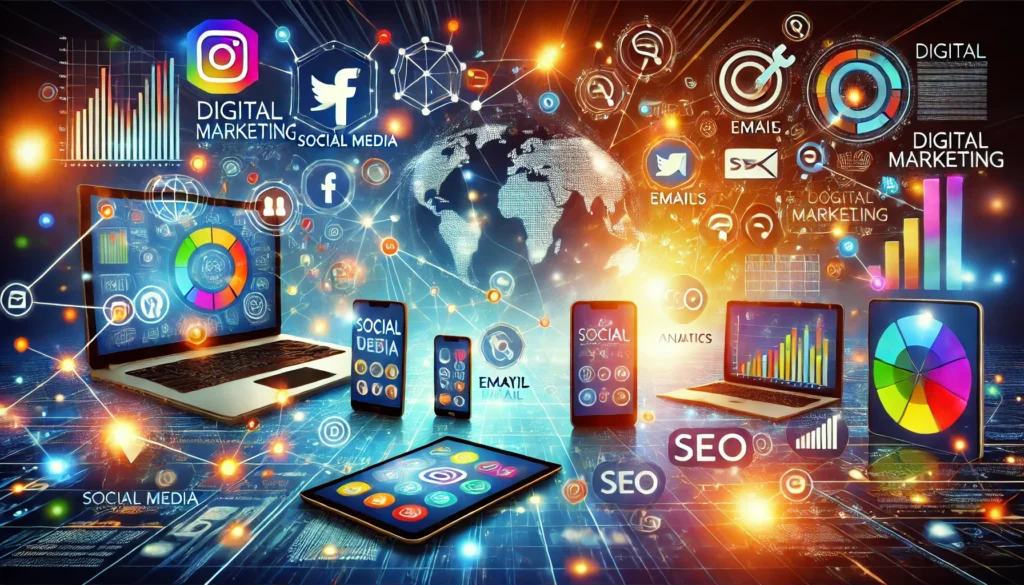
Introduction
In today’s technology-driven world, businesses must adapt to reach customers effectively. Traditional marketing methods, like billboards and radio ads, are no longer sufficient. Enter digital marketing—the ultimate way to connect with audiences online, where they spend most of their time.
This guide will explain what digital marketing is, why it’s vital for modern businesses, and how you can begin leveraging it for success.
Section 1: Understanding Digital Marketing
What is Digital Marketing?
Digital marketing uses online channels like websites, social media, email, and search engines to promote products or services. Unlike traditional methods, digital marketing allows businesses to engage directly with specific audiences, tailoring messages to resonate with their target demographic.
Key Components of Digital Marketing
- Websites: Your online presence’s foundation, providing essential information about your brand and offerings.
- Social Media Platforms: Build brand awareness and interact with your audience.
- Analytics Tools: Measure performance and refine strategies using data-driven insights.
Section 2: The Core Channels of Digital Marketing
1. Search Engine Optimization (SEO)
SEO improves your website’s visibility on search engines like Google. By optimizing your site’s content and structure, you can rank higher in search results and attract more visitors.
Key Tips:
- Conduct keyword research.
- Create high-quality, relevant content.
- Ensure your website is mobile-friendly and loads quickly.
2. Content Marketing
Content marketing involves creating and sharing valuable resources like blog posts, videos, and infographics to attract and engage your audience. The goal is to build trust and loyalty by solving their problems.
Key Tips:
- Understand your audience’s needs.
- Maintain a consistent publishing schedule.
- Prioritize quality over quantity.
3. Social Media Marketing
Social media platforms like Instagram, Facebook, LinkedIn, and Twitter offer unique opportunities to engage with your audience. Through posts, ads, and interactions, you can enhance brand visibility and drive traffic.
Key Tips:
- Focus on platforms your audience uses most.
- Post engaging, relatable content consistently.
- Respond to comments and messages promptly.
4. Email Marketing
Email remains a powerful way to reach your audience directly. It’s ideal for promotions, updates, and nurturing leads.
Key Tips:
- Build your email list organically.
- Segment your audience for tailored campaigns.
- Include a clear call-to-action (CTA).
5. Pay-Per-Click (PPC) Advertising
PPC advertising involves paying for ad placements on search engines or social media. You pay only when someone clicks on your ad, making it a cost-effective option.
Key Tips:
- Set a clear budget.
- Target specific keywords.
- Monitor ad performance and adjust as needed.
6. Affiliate and Influencer Marketing
Affiliate marketing involves partnering with individuals or companies who promote your products for a commission. Influencer marketing uses social media personalities to endorse your brand.
Key Tips:
- Collaborate with partners whose audience aligns with yours.
- Define clear terms for the partnership.
Section 3: Benefits of Digital Marketing
Digital marketing revolutionizes how businesses connect with their audiences. Here’s why it’s indispensable:
- Cost-Effectiveness: Affordable compared to traditional methods, with high ROI.
- Measurable Results: Track campaigns in real time using tools like Google Analytics.
- Global Reach: Reach customers worldwide, breaking geographical barriers.
- Targeted Audience Engagement: Tailor campaigns to specific demographics.
- Flexibility: Adjust strategies on the fly to align with goals or trends.
Section 4: Getting Started with Digital Marketing
1. Set Your Goals
Identify what you want to achieve—brand awareness, lead generation, or sales. Clear goals shape your strategy.
2. Identify Your Target Audience
Understand your ideal customer’s demographics, interests, and online behavior.
3. Choose the Right Platforms
Focus on channels that align with your goals. For example:
- A fashion brand might prioritize Instagram.
- A B2B company may focus on LinkedIn.
4. Track Your Performance
Use tools like Google Analytics, social media insights, and email software to monitor your campaigns. Analyze data to refine your strategy.
Section 5: Challenges and Solutions in Digital Marketing
Common Challenges:
- Keeping Up with Trends:
The digital landscape evolves rapidly.
Solution: Follow industry blogs, attend webinars, and network. - Overwhelming Competition:
Standing out is tough in crowded markets.
Solution: Highlight your unique value proposition (UVP). - Limited Budget:
New marketers often have tight budgets.
Solution: Start with cost-effective strategies like SEO and email marketing. - Measuring ROI:
Proving success can be tricky.
Solution: Define metrics for success and review analytics regularly.
Conclusion
Digital marketing is a game-changer for businesses of all sizes. It offers limitless opportunities to connect with audiences, build brand awareness, and drive growth.
Getting started may seem daunting, but with clear goals, the right tools, and a willingness to adapt, success is within your grasp.
Ready to Begin?
Start with one or two digital marketing channels, track your performance, and expand as you gain confidence. The digital world is vast, but with determination and a strategic approach, your business can thrive.
Call to Action
Explore our free digital marketing resources or sign up for our comprehensive step-by-step course to master the essentials of digital marketing today!